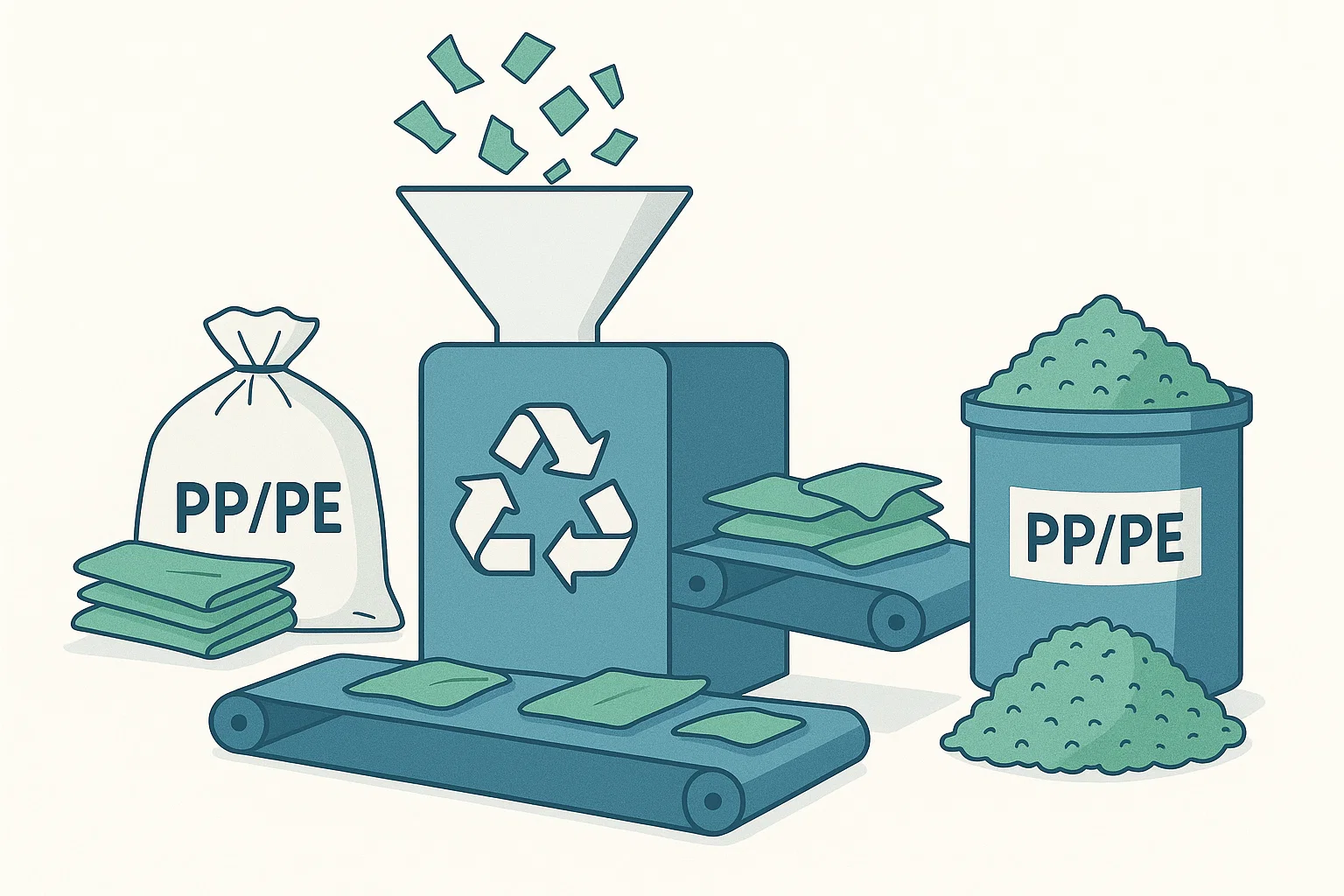PP/PE Film Recycling'de Densifikasyonun Temel Rolü: Kapsamlı Bir Rehber
Paketli, su dolu plastik film atıkla uğraşıyor musunuz ki bu, taşımacılıkta pahalı ve işleme zor? %%
Plastik geri dönüşüm işindeyseniz, PP ve PE filmlerin özel zorluklarını biliyorsunuz. Hafifler, devasa miktarda yer kaplıyorlar ve yıkandıktan sonra önemli miktarda nem tutuyorlar. İşte bu noktada yoğunlaştırma sizin oyununuzu değiştiriyor.
%%
Yoğunlaştırma, serbest, nemli plastik filmi yoğun, yüksek yoğunluklu malzeme haline dönüştürerek, yıkama ve granüleme arasındaki kritik köprüyü oluşturur. Bu, geri dönüşüm operasyonunuzun karlılığını belirleyebilir.
%%
Yoğunluk Artışı
%%
kg/m³ Yoğunluk
%%
Neden Modern Film Geri Dönüşümü İçin Yoğunlaştırma Mümkün Olmaz?
%%
Açıkçası, yoğunlaştırma adımını atlamak ekipman maliyetlerinden tasarruf etmek gibi görünebilir, ancak daha sonra çok daha pahalı sorunlar yaratır. İşte densifikasyonun profesyonel geri dönüşüm operasyonlarında standart haline gelmesinin nedenleri:
%%
Azalan Taşımacılık Maliyetleri
%%
Serbest film atık çoğunlukla havadır. Yoğunlaştırma yapıldıktan sonra, gerçek malzeme yerine boş alan taşımacılıyorsunuz. Bu, bir kamyonet yükünde 10 kat daha fazla ürünü taşımanızı sağlar ve lojistik maliyetlerinizi ve karbon ayak izinizi önemli ölçüde azaltır.
%%
%%
Daha Yüksek Malzeme Değeri
- %%
- Alıcılar, işlenmesi kolay ve daha iyi son ürünler üreten yoğunlaştırılmış malzeme için yüksek fiyat öderler. Sadece geri dönüştürmüyoruz, rekabetçi pazar fiyatlarına sahip değerli bir malzemeyi yaratıyoruz.
- %%
- Yoğunlaştırma Süreci: Nasıl Çalıştığı Hakkında Gerçek Bilgi
- %%
- Adım Adım Çalışma Akışı
- %%
Bale film malzemesi, genellikle 30-50mm boyutunda küçük parçalara ayrılır, bu da sonraki işleme için yönetilebilir hale getirir.
- %%
- Parçalara ayrılmış filmler, kir, etiketler, yapıştırıcılar ve diğer kirleticilerden kurtulmak için yüksek frizyon yıkayıcılar üzerinden geçer.
- %%
- Ağır Kirleticilerden Ayrılma:
- %%
- Taşlar, kum ve metaller gibi ağır kirleticiler yoğunluk ayırma yoluyla kaldırılır, bu da temiz girdi malzemesi sağlar.
- %%
Yoğunlaştırma:
%%
- Temiz, nemli parçalar, mekanik basınç ve kontrol edilen ısı ile yoğunlaştırıcıya girer ve yoğun, düşük nemli pellet veya aglomere dönüştürülür. %%
- Yoğunlaştırılmış malzeme, pelletizere veya extruderlere dengeli bir şekilde beslenir ve üretim için hazır, dengeli granül üretir. %%
- Yoğunlaştırma ile Doğrudan Pelletizasyon: Doğru Seçimi Yapmak %%
- Yoğunlaştırma ile %%
- Pelletizere dengeli, öngörülebilir besleme %%
- Nemle ilgili kalite sorunlarının azalması %%
- Pahalı alt akış ekipmanlarının aşınmasının azalması %%
- Ton başına işlenen malzeme için daha düşük enerji tüketimi %%
- Çevresel Etki: Daha yüksek kaliteli ve daha iyi özelliklere sahip son pelletler
- %% Daha iyi süreç kontrolü, kalite standartlarını karşılamaya yardımcı olur
%%
Endüstri İçgörüsü %% Profesyonel geri dönüşümçiler, yoğunlaştırma adımının eklenmesinin, taşımacılık, enerji ve malzeme fiyatlandırmasında sağlanan toplam tasarruflar sayesinde genel karlılığı -40 artırabileceğini bildiriyorlar. Ekipman genellikle 12-18 ay içinde kendini amorti ediyor.
%%
Yoğunlaştırma Ekipman Türleri: Operasyonunuza Uygun Olanı Seçmek
%%
En iyisi: Tüm yoğunlaştırma ekipmanları eşit değildir. Ana türler hakkında bilmeniz gerekenler şunlardır:
%%
Toplayıcılar
En iyisi: Screw Squeezers
%%
Yüksek kapasiteli, öncelikle nemli film işleyen operasyonlar
En iyisi: %%
Bu iş gücü makineleri, suyu ve malzemeyi aynı anda sıkarak sıkıştırır. Güvenilir, nispeten düşük bakım gerektiren ve sürekli işletim için mükemmeldir.
%%
En iyisi: Kuru veya yarı kuru filmden homojen, yüksek yoğunluklu granüller oluşturma
%%
Agglomerators, film partikellerinin yüzeyini yüksek hızlı dönen bıçaklarla ısıtarak eritmek suretiyle yoğun granüller haline gelmelerini sağlar. Dıştan ısıtma gerektirmez - doğru uygulamalar için enerji verimlidir.
%%
- Compactors
- %%
- Orta kapasiteli genel amaçlı yoğunlaştırma
- %%
- Versatil makineler, mekanik basınç yoluyla malzeme sıkıştırır. Tasarımı daha basit, bakımı daha kolay ve küçük operasyonlar veya modüler sistemlerin bir parçası olarak iyi çalışır.
- %%
- Integrated Systems
%% Tamamlanmış işletimler, sorunsuz işleme isteyenler
%%
Bütün bileşenlerin birbirleriyle çalışmak üzere tasarlandığı tamamen entegre parçalara sahip parçalama-yıkama-yoğunlaştırma hatları. Bu sistemler en yüksek verimliliği sunar ancak daha büyük başlangıç yatırımını ve özel alan gerektirir.
%%
Karar Kılavuzu: Yoğunlaştırma Operasyonunuza Uygun Mu?
- %%
- 500 kg/saat'ten fazla PP/PE film atık işlediğinizde kesinlikle yoğunlaştırma ihtiyacınız vardır.
- Geri dönüştürülmüş malzemeyi diğer tesisler veya müşterilere gönderiyorsanız.
- Yazılılmış filmler, tarım filmleri veya ince ambalaj filmleri ile çalışıyorsanız.
Üst sınıf geri dönüştürülmüş granüller üretmek istiyorsanız.
Sıkça aşağı akımdaki ekipman sorunları yaşıyorsanız.
Verim Kapasitesi
Depolama alanınız sınırlı ve pahalıysa.
Malzemenizin pazar değerini maksimize etmek istiyorsanız.
Yoğunlaştırma yapmayı atlamak için sadece:
Enerji verimliliği
Çok küçük ölçekli bir operasyonunuz varsa (200 kg/saat'ten az), sadece kalın, kuru filmleri işler ve özel ekipmanla anında yerinde yoğunlaştırırsanız.
%%
Çevresel ve Ekonomik Etki: Geniş Manzara
%%
Yoğunlaştırma sadece operasyonel verimlilikle sınırlı değildir - döngüsel ekonomi için kritik bir destekleyicidir. Film geri dönüşümünü ekonomik hale getirerek, her yıl milyonlarca ton plastik atığı çöplerden ve denizlerden uzaklaştırır. %% Matematikleri düşünün: geleneksel serbest film geri dönüşümü, işleme kayıpları ve kontaminasyon nedeniyle 60-70% malzeme geri kazanımına ulaşabilir. Good-designed densifying system can push that to 90-95% recovery while producing higher-quality output. That difference represents enormous environmental impact when scaled across the industry.
%%İş açısından, yoğunlaştırma, birden fazla gelir fırsatı yaratır. Satın:
Yoğunlaştırılmış malzemeyi pelletizlere yüksek fiyatlarla satın.
Her iki süreci entegre ettiğinizde kendi pelletizleme maliyetlerinizi azaltın.
Düşük kaliteli girdi malzemesi kabul edin ve hala satılabilir çıktı üretin.
Taşımacılık daha ekonomik olduğundan coğrafi hizmet alanınızı genişletin.



